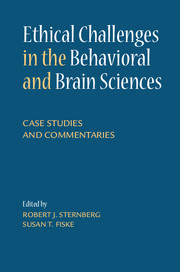Book contents
- Frontmatter
- Contents
- List of Contributors
- Preface
- Part I Academic Cheating
- Part II Academic Excuses and Fairness
- 5 The Compassionate Instructor Doesn’t Always Award Extra Credit
- 6 An Ethical Dilemma in Teaching
- 7 Attempted Retribution by a Disgruntled Individual
- 8 Grading and the “Fairness Doctrine”
- 9 Managing and Responding to Requests by Students Seeking to Improve Their Achievement-Related Outcomes
- 10 Are There Times When Something Is of Greater Importance Than the Truth?
- 11 Commentary to Part II
- Part III Authorship and Credit
- Part IV Confidentiality’s Limits
- Part V Data Analysis, Reporting, and Sharing
- Part VI Designing Research
- Part VII Fabricating Data
- Part VIII Human Subjects
- Part IX Personnel Decisions
- Part X Reviewing and Editing
- Part XI Science for Hire and Conflict of Interest
- Epilogue Why Is Ethical Behavior Challenging?
- Index
8 - Grading and the “Fairness Doctrine”
Published online by Cambridge University Press: 05 February 2015
- Frontmatter
- Contents
- List of Contributors
- Preface
- Part I Academic Cheating
- Part II Academic Excuses and Fairness
- 5 The Compassionate Instructor Doesn’t Always Award Extra Credit
- 6 An Ethical Dilemma in Teaching
- 7 Attempted Retribution by a Disgruntled Individual
- 8 Grading and the “Fairness Doctrine”
- 9 Managing and Responding to Requests by Students Seeking to Improve Their Achievement-Related Outcomes
- 10 Are There Times When Something Is of Greater Importance Than the Truth?
- 11 Commentary to Part II
- Part III Authorship and Credit
- Part IV Confidentiality’s Limits
- Part V Data Analysis, Reporting, and Sharing
- Part VI Designing Research
- Part VII Fabricating Data
- Part VIII Human Subjects
- Part IX Personnel Decisions
- Part X Reviewing and Editing
- Part XI Science for Hire and Conflict of Interest
- Epilogue Why Is Ethical Behavior Challenging?
- Index
Summary
At most universities instructors are encouraged to state their grading policies in the class syllabus, preferably along with numerical ranges for each grade. Ignoring these guidelines can get you in trouble, especially if a disgruntled student chooses to file a grade appeal. If the student can demonstrate that his or her grade does not match what has been given to other students, or if the grade criteria are not explicitly outlined in the syllabus, then the student has a reasonable chance of winning a grade appeal. Special attention is typically given to a “fairness” criterion – all students in the class should be graded in the same way.
But for those of us who teach large classes, in my case more than 400 students in an introductory psychology course, sticking to the “fairness doctrine” can be a challenge. The final grade is based almost entirely on three or four multiple-choice tests, so poor performance on the first (or any) test can put the student in a hopeless situation. Imagine that I give three 100-point multiple-choice tests and the cutoff for a C is a cumulative 210. Student A flunks the first test, receiving a score of 44, but judiciously comes to office hours and performs well on the second exam (70) and even better on the third (90). Student B never comes to office hours, shows no improvement across tests, but ends up with the same final total (68 + 68 + 68). Do these two students really deserve the same grade?
- Type
- Chapter
- Information
- Ethical Challenges in the Behavioral and Brain SciencesCase Studies and Commentaries, pp. 22 - 24Publisher: Cambridge University PressPrint publication year: 2015

